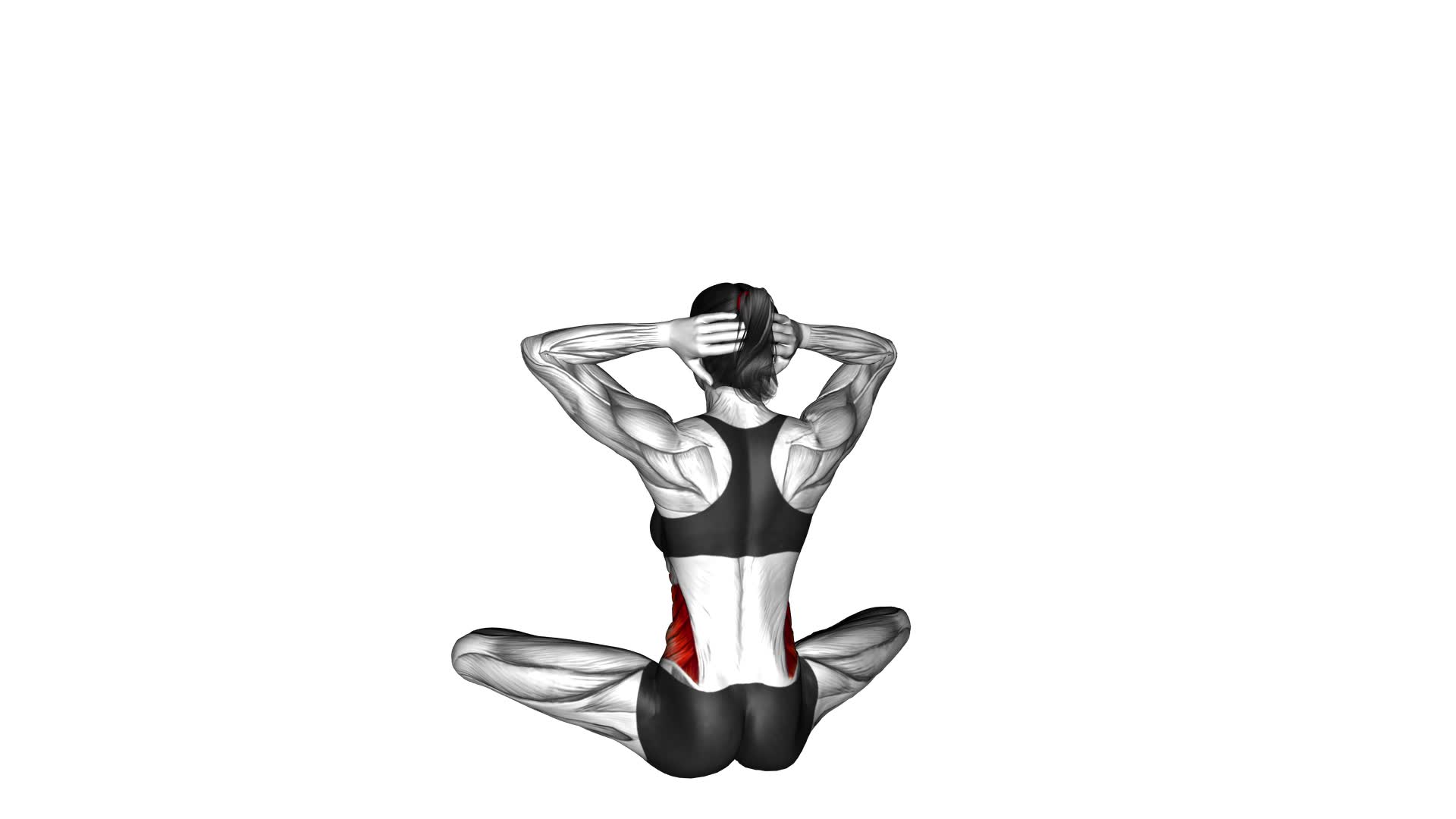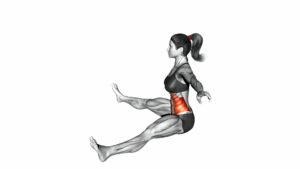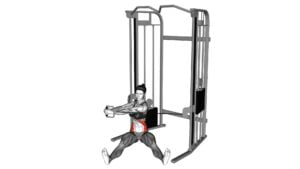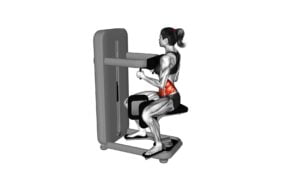Seated Back Twist (female) – Video Exercise Guide & Tips

Are you looking to strengthen your core and improve your flexibility? Then the Seated Back Twist is the perfect exercise for you.
Watch This Exercise Video
In this video exercise guide, we will show you step-by-step how to perform the Seated Back Twist correctly to maximize its benefits. Avoid common mistakes and learn tips for making this exercise more effective.
Whether you are a beginner or advanced, modifications and variations are provided for all fitness levels.
Let's get started!
Key Takeaways
- The Seated Back Twist improves spinal mobility and increases flexibility.
- Engaging core muscles and releasing tension in the muscles surrounding the spine are important benefits of this exercise.
- The Seated Back Twist promotes a healthy range of motion in the spine.
- To maximize the effectiveness of the exercise, it is important to keep the spine tall and straight, engage the core muscles, and use controlled breathing techniques.
Benefits of the Seated Back Twist
To experience the benefits of the Seated Back Twist, start by sitting comfortably on the floor with your legs crossed. This exercise offers numerous advantages, especially when it comes to spinal mobility and core strength integration.
First and foremost, the Seated Back Twist is vital for maintaining and improving spinal mobility. As we age, our spines tend to become less flexible, leading to stiffness and discomfort. By incorporating this exercise into your routine, you can counteract these effects and promote a healthy range of motion in your spine. The twisting motion actively engages the muscles surrounding the spine, helping to release tension and increase flexibility.
Additionally, the Seated Back Twist is an excellent way to work on core strength while seated. While many core exercises focus on the abs, this exercise targets the deep muscles of the core, including the obliques and the muscles that support the spine. By strengthening these muscles, you can improve your posture, stability, and overall functional fitness.
How to Perform the Seated Back Twist
To perform the Seated Back Twist, start by sitting comfortably on the floor with your legs crossed. This exercise is a great way to stretch and strengthen your back muscles, while also improving your posture and flexibility.
Beginners may find it helpful to modify the Seated Back Twist by using a yoga block or a folded blanket for support. Place the block or blanket under your sitting bones to elevate your hips slightly, which can make it easier to twist. This modification helps to reduce strain on the lower back and allows you to focus on the twisting motion.
To perform the Seated Back Twist, place your right hand on the floor behind you, close to your tailbone. Inhale deeply and on the exhale, gently twist your torso to the right, using your left hand to guide the twist. Keep your spine tall and lengthened as you twist, and avoid collapsing into the twist. Hold the twist for a few breaths, then slowly release and repeat on the other side.
Remember to listen to your body and gradually increase the intensity of the twist over time. With regular practice, the Seated Back Twist can help improve your spinal mobility and overall back health.
Common Mistakes to Avoid
- Avoid collapsing into the twist and maintain a tall and lengthened spine as you perform the Seated Back Twist. One of the most common mistakes people make when performing this exercise is allowing their posture to suffer. It's important to remember that proper form is essential in order to maximize the effectiveness of the exercise and prevent injury.
To maintain the correct form, start by sitting on the floor with your legs extended in front of you. Bend your right knee and place your right foot on the outside of your left knee. Keep your left leg straight and engaged. Place your left hand on the floor behind you for support, and bring your right arm across your body, placing your elbow on the outside of your right knee.
The mistake to avoid here is collapsing forward or rounding your spine. Instead, focus on keeping your spine tall and lengthened. Imagine that you're sitting against a wall, with your shoulder blades gently pressed against it. This will help you maintain the proper alignment.
By avoiding these common mistakes and maintaining a tall and lengthened spine, you'll be able to perform the Seated Back Twist with proper form, which will maximize the effectiveness of the exercise and help you achieve your fitness goals.
Now, let's move on to the next section where we'll discuss some tips for maximizing the effectiveness of the exercise.
Tips for Maximizing the Effectiveness of the Exercise
To enhance the effectiveness of the exercise, focus on maintaining proper alignment and engaging your core throughout the Seated Back Twist. By following these tips, you can make the most out of this exercise:
- Keep your spine tall and straight: Imagine a string pulling you up from the top of your head, lengthening your spine. This will help maintain proper alignment and prevent any unnecessary strain on your back.
- Engage your core muscles: Throughout the entire movement, be sure to activate your core muscles. This won't only help stabilize your body but also increase the intensity of the twist.
- Use controlled breathing: As you twist, inhale deeply through your nose, and exhale slowly through your mouth. This controlled breathing technique helps to oxygenate your muscles and promote relaxation.
By implementing these tips, you can optimize the effectiveness of the Seated Back Twist, targeting your back muscles and improving your flexibility.
Now, let's explore some modifications and variations for all fitness levels to ensure that everyone can benefit from this exercise.
Modifications and Variations for All Fitness Levels
Explore different modifications and variations of the Seated Back Twist to accommodate individuals of all fitness levels. Whether you're a beginner or an advanced exerciser, there are options to suit your needs and help you progress in your fitness journey.
For those who are new to the Seated Back Twist, it's important to start with the basic version and focus on proper form. Sit on the floor with your legs extended in front of you, bend your right knee, and place your right foot outside of your left knee. Place your left hand on your right knee and reach your right arm behind you, twisting your torso to the right. Hold the twist for a few breaths, then switch sides.
To modify the exercise and make it more accessible, you can use a yoga block or a folded blanket to sit on. This will elevate your hips and make it easier to rotate your torso. You can also keep your legs straight instead of bending the knee, which will reduce the intensity of the twist.
For those looking for a challenge, you can progress the Seated Back Twist by adding resistance. Hold a dumbbell or a resistance band in your hands while performing the exercise, which will engage your upper body muscles even more.
Remember to listen to your body and choose the modification or progression that feels right for you. With practice and consistency, you'll be able to improve your flexibility and strength with the Seated Back Twist.
Frequently Asked Questions
Can the Seated Back Twist Help With Reducing Lower Back Pain?
The seated back twist can be beneficial for reducing lower back pain. By gently twisting your torso, you can stretch and strengthen the muscles in your lower back. This exercise helps improve flexibility and mobility, relieving tension and discomfort.
Additionally, there are modifications you can make to accommodate any limitations or injuries you may have. Incorporating the seated back twist into your routine can be a helpful tool in managing lower back pain.
Is the Seated Back Twist Suitable for Pregnant Women?
Yes, the seated back twist can be modified for pregnant women. It's important to consult with your healthcare provider before attempting any exercises during pregnancy.
The seated back twist can help improve flexibility and relieve tension in the back, which can be beneficial for postpartum recovery. However, it's crucial to listen to your body and avoid any movements that cause discomfort or strain.
Always prioritize your safety and the well-being of your baby.
How Many Calories Can Be Burned by Performing the Seated Back Twist?
Performing the seated back twist can help you burn calories and contribute to weight loss.
While the exact number of calories burned depends on factors such as your weight, intensity, and duration of the exercise, twisting movements engage your core muscles and can increase your heart rate.
This can lead to an increase in calorie expenditure and potentially aid in achieving your weight loss goals.
Remember to consult with a healthcare professional before starting any exercise program.
Can the Seated Back Twist Improve Digestion?
The seated back twist is a beneficial exercise for improving digestion and overall gut health. By incorporating the seated back twist into your routine, you can help alleviate bloating and promote healthy digestion.
This exercise targets the muscles in your core, stimulating the digestive system and increasing blood flow to the abdominal area. Regular practice of the seated back twist can contribute to a healthier gut and improved digestion.
Are There Any Specific Breathing Techniques to Be Followed During the Seated Back Twist?
During the seated back twist, it's important to focus on your breathing.
Deep breathing can provide several benefits during exercise.
As you twist your torso, inhale deeply through your nose and exhale through your mouth.
This can help you maintain control and stability throughout the movement.
Conclusion
Incorporating the seated back twist into your exercise routine can provide numerous benefits. This includes improved spinal mobility and reduction of lower back pain. By following the proper technique and avoiding common mistakes, you can maximize the effectiveness of this exercise.
Additionally, modifications and variations can be made to suit different fitness levels. So grab a mat, give the seated back twist a try, and experience the positive impact it can have on your overall well-being.

Author
Years ago, the spark of my life’s passion ignited in my mind the moment I stepped into the local gym for the first time. The inaugural bead of perspiration, the initial endeavor, the very first surge of endorphins, and a sense of pride that washed over me post-workout marked the beginning of my deep-seated interest in strength sports, fitness, and sports nutrition. This very curiosity blossomed rapidly into a profound fascination, propelling me to earn a Master’s degree in Physical Education from the Academy of Physical Education in Krakow, followed by a Sports Manager diploma from the Jagiellonian University. My journey of growth led me to gain more specialized qualifications, such as being a certified personal trainer with a focus on sports dietetics, a lifeguard, and an instructor for wellness and corrective gymnastics. Theoretical knowledge paired seamlessly with practical experience, reinforcing my belief that the transformation of individuals under my guidance was also a reflection of my personal growth. This belief holds true even today. Each day, I strive to push the boundaries and explore new realms. These realms gently elevate me to greater heights. The unique combination of passion for my field and the continuous quest for growth fuels my drive to break new ground.







